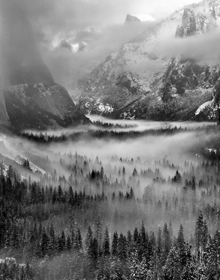
BREATHTAKING Jameson’s Dawn Mist, Yosemite, California. |
Philip Jameson, an 82-year-old retired radiologist in Providence, is one of the great living practitioners of one of the great traditions of American art — Ansel Adams's monumental, romantic style of landscape photography.Jameson's best work — like his 1991 photo Dawn Mist, Yosemite, California, on view in his solo show at Candita Clayton Studio (999 Main St, unit 105, Pawtucket, through November 23) — is breathtaking. Mist drifts hauntingly over snow-frosted evergreens in the vast valley between Yosemite's iconic cliffs. We can feel the chill of the snow, the bristly trees, the cottony softness of the mist, the hard angles and mass of the mountains. The 4-½-foot tall print is awesome in the old shudder-in-the-presence-of-great-power sense of the word.
The richness of the print is due to Jameson's eye, his gear (a bulky old-fashioned camera using 8x10-inch film that vacuums up detail), his printing technique (which vividly reproduces those details), as well as his patient planning. His vision of the image enabled him to figure out where to be and how long to wait to capture it.
"I think it was about 10 o'clock in the morning and it was socked in fog," Jameson recalls. "I was waiting for the sun to come up over the mountain and to hit the fog to see what would happen. I waited for about an hour and a half, two hours. Exactly as I expected, the sun eventually came and the image revealed itself to me exactly as I had pre-visualized it. I found that the fog was breaking up and it was hitting El Capitan on the left and bouncing off of it and then going all the way up and covering Half Dome. I had pre-visualized it and I got really lucky.
"You don't shoot indiscriminately, because every time I take an exposure it's an enormous expense for me both emotionally and physically and economically," he says.
Jameson took up photography in the late 1960s, studying the works and writings of Adams, Alfred Stieglitz, and Edward Weston. He boned up on optics and photo printing chemistry. And he photographed 1000-year-old monasteries perched in the mountains of Greece, shimmering cottonwood trees against the dark rock of an Arizona canyon, the crisp Yankee steeple of Providence's First Unitarian Church haloed by clouds, and an eerie vacant Nantucket cobblestone street lined with bare trees under an oppressive gray sky.
His 1992 photo of Sunset, Snake River, Jackson, Wyoming captures the last rays of sun glowing through the silhouetted peaks and lighting up the iconic river bend. The photo's drama stands on its own. But Jameson's mastery is also apparent in how subtly he attends to the varying tones of the forest in the foreground, carefully describing trees already shrouded by night.
Jameson is clearly following in the footsteps of Adams — artistically via his clear, classic Modernism, but also literally as he walks Yosemite. Beginning in the 1960s and '70s, leaders in art photography rejected the romantic Modernism of photographers like Adams, Weston, and Paul Strand in favor of the more mechanical, deadpan "New Topographics" approach that continues to dominate photography today. So Jameson is among a handful of major photographers in New England — including Salvatore Mancini here and Paul Caponigro in Maine — and nationally still doing excellent work mining this territory.